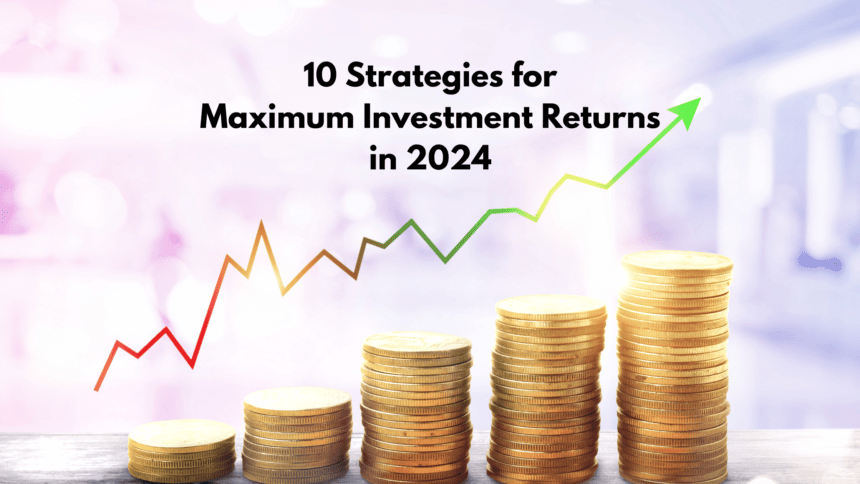Introduction
In the ever-evolving world of finance, 2024 offers a plethora of opportunities for savvy investors. Strategic investing is more crucial than ever to navigate this dynamic landscape and maximize returns. This guide explores ten robust investment strategies designed to help investors achieve their financial goals in the coming year.
10 Best Investment Strategies for 2024
Here are the list of 10 best investment strategies for 2024
1. Diversification
Diversification is the bedrock of sound investing. The principle is simple yet powerful: don’t put all your eggs in one basket. By spreading investments across various asset classes, sectors, and geographies, investors can mitigate risk and enhance potential returns.
A well-diversified portfolio reduces exposure to any single asset, thereby cushioning against market volatility. For instance, if one sector underperforms, gains in another can offset the losses. Diversification can be achieved through various means, such as combining stocks, bonds, real estate, and commodities. This approach not only protects against market downturns but also captures the growth potential across different investment avenues.
2. High-Growth Tech Stocks
The technology sector remains a hotbed of innovation and growth. Identifying high-potential technology sectors, such as artificial intelligence, renewable energy, and biotechnology, can yield substantial returns. These areas are revolutionizing industries and creating new market opportunities.
Investors should focus on companies with strong fundamentals, innovative products, and a track record of consistent growth. Evaluating factors such as revenue growth, profit margins, and research and development (R&D) spending can help in selecting promising tech stocks. While the tech sector can be volatile, its long-term growth potential makes it an attractive option for investors willing to endure short-term fluctuations.
3. Sustainable and ESG Investing
Environmental, Social, and Governance (ESG) criteria have gained significant traction among investors. Sustainable investing not only supports ethical practices but also offers attractive returns. Companies with strong ESG practices tend to be better managed, face fewer regulatory risks, and enjoy stronger brand loyalty.
By selecting companies with robust ESG practices, investors can contribute to a better world while potentially enjoying superior financial performance. For instance, renewable energy companies are poised to benefit from the global shift towards sustainable energy sources. ESG investing also encompasses social and governance factors, such as labor practices and corporate governance, which can impact a company’s long-term success.
4. Real Estate Investment Trusts (REITs)
REITs provide an accessible way to invest in real estate without the need for significant capital. These trusts own, operate, or finance income-generating real estate across various sectors, including residential, commercial, and industrial properties.
Key factors to consider when investing in REITs include the type of real estate, geographic location, and the trust’s financial health. REITs offer diversification, regular income through dividends, and potential for capital appreciation. They are particularly attractive for income-focused investors seeking exposure to the real estate market without the complexities of direct property ownership.
5. Cryptocurrency and Blockchain Technology
Cryptocurrencies and blockchain technology have revolutionized the financial landscape. Despite their volatility, digital assets like Bitcoin and Ethereum present lucrative investment opportunities. The blockchain technology underpinning these cryptocurrencies offers transformative potential across various industries, from finance to supply chain management.
Investors should adopt a cautious approach, conducting thorough research and diversifying their crypto portfolio to manage risks effectively. Understanding the underlying technology, market trends, and regulatory environment is crucial. While cryptocurrencies can experience dramatic price swings, their potential for high returns makes them an intriguing component of a diversified investment strategy.
6. Dividend Stocks
Dividend stocks provide a steady income stream, making them attractive to long-term investors. Companies with a history of paying consistent and increasing dividends are often financially stable and well-managed. Dividends not only offer regular income but also signal a company’s confidence in its financial health and future prospects.
Evaluating a company’s dividend yield, payout ratio, and growth prospects can help in selecting reliable dividend stocks. For instance, a high dividend yield may be enticing, but it’s essential to ensure that the company can sustain its payouts. Dividend growth stocks, which consistently increase their dividends, can provide both income and capital appreciation over time.
7. Global Market Investments
Investing in international markets allows investors to tap into the growth potential of emerging economies. Countries like China, India, and Brazil offer compelling opportunities due to their rapid economic growth and expanding consumer bases.
While global investments offer diversification and higher returns, they also come with risks such as currency fluctuations, political instability, and regulatory differences. Conducting thorough research and understanding the economic conditions of target countries is crucial. Additionally, considering geopolitical factors and currency risks can help investors make informed decisions and capitalize on global growth opportunities.
8. Fixed Income Securities
Bonds and other fixed income securities offer stability and predictable returns. These instruments play a vital role in balancing risk within a portfolio. Fixed income securities can include government bonds, corporate bonds, municipal bonds, and treasury securities.
Understanding the credit rating, interest rate environment, and maturity of fixed income securities is essential for optimizing returns and managing risks. For instance, government bonds are generally considered safer than corporate bonds, but they may offer lower yields. Investors should also be aware of interest rate risk, as rising rates can negatively impact bond prices. Despite these risks, fixed income securities can provide a steady income stream and diversification benefits.
9. Alternative Investments
Alternative assets, including art, wine, and private equity, provide diversification beyond traditional investments. These assets often have low correlation with stock markets, offering protection during market downturns. For example, fine art can retain its value or even appreciate during economic downturns, providing a hedge against market volatility.
However, alternative investments require specialized knowledge and carry unique risks, such as liquidity and valuation challenges. Investing in these assets often involves higher fees and longer investment horizons. Nonetheless, for those with the expertise or access to professional advice, alternative investments can enhance portfolio diversification and offer potential for high returns.
10. Robo-Advisors and Automated Investing
Robo-advisors have democratized access to professional financial advice. These automated platforms use algorithms to create and manage investment portfolios based on individual goals and risk tolerance. By leveraging technology, robo-advisors offer cost-effective and efficient portfolio management solutions.
Choosing the right robo-advisor involves evaluating fees, investment options, and the platform’s track record. Robo-advisors typically offer diversified portfolios, regular rebalancing, and tax optimization strategies. They are particularly beneficial for novice investors or those seeking a hands-off approach to investing. As technology continues to evolve, robo-advisors are likely to play an increasingly significant role in personal finance management.
Conclusion
In 2024, investors have a multitude of investment strategies at their disposal to maximize returns. By diversifying portfolios, exploring high-growth sectors, embracing sustainable investing, and utilizing advanced tools like robo-advisors, investors can navigate the complexities of the market. Each investment strategies offers unique benefits and risks, making it essential for investors to conduct thorough research and align their choices with their financial goals and risk tolerance. Implementing these investment strategies with diligence and foresight will be key to achieving financial success in the year ahead.
For more content follow Humstory.













